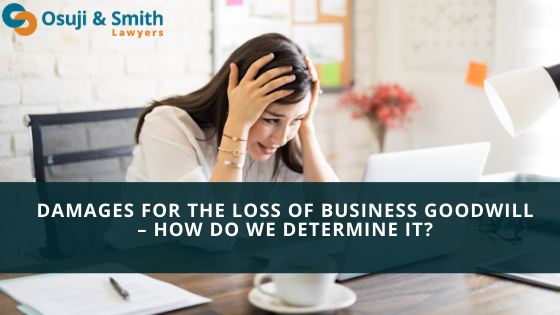 In actions for breach of contract where the non-performance of a contractual obligation or anticompetitive behavior caused injury to the business reputation, we commonly see the plaintiff claiming damages for the loss of business goodwill. So, what is goodwill of a business, and how do we ascertain the loss of goodwill in a lawsuit?
In actions for breach of contract where the non-performance of a contractual obligation or anticompetitive behavior caused injury to the business reputation, we commonly see the plaintiff claiming damages for the loss of business goodwill. So, what is goodwill of a business, and how do we ascertain the loss of goodwill in a lawsuit?
Typically, a business is comprised of tangible and intangible assets. Tangible assets include equipment, property, and inventory. Intangible assets include brand names, trademarks, reputation, and reputation attached to the business.
Goodwill of a business is a nebulous concept which the courts have described as follows:
- Goodwill of a business connotes the positive association that attracts customers towards its owner’s ware or services rather than those of its competitors (Veuve Clicquot Ponsardin v Boutiques Cliquot Ltee, 2006 SCC 23, at para 50);
- Goodwill arises by how a company does its business and the ways in which it distinguishes its services (Corus Radio Inc v Harvard Broadcasting Inc, 2019 ABQB 880at para 87); and
- Goodwill is the difference between the going concern value and the tangible asset backing (see Shell Canada Ltd v Alberta (Minister of Transportation &n Utilities, (1991) 46 LCR 133at para 65 (ABQB)).
The Courts have acknowledged that goodwill can be financially ascertained. It often appears on corporate financial statements. So how do we calculate damages for the loss of goodwill?
The Canadian Institute of Charted Accountants suggests a six-step approach to valuing goodwill. These steps include:
- examining the earnings record,
- adjusting past earnings to arrive at future maintainable profits;
- determining the appropriate rate of return that should be realized on an investment in the particular type of business;
- determining total value by capitalizing the earnings as adjusted by the rate of interest,
- valuing tangible and intangible assets other than goodwill; and then
- calculating the difference between the value of the assets and the capitalized earnings.
(see Surrey Animal Hospital Ltd. v British Columbia (Minister of Transportation and Highways) 1993 CarswellBC 2730, 51 L.C.R. 37 at para 60).
The Courts have noted that this six-step approach has been used by several experts and have been sanctioned by the Courts in jurisprudence. As a word of caution, the courts have indicated that computation of damages for the loss of goodwill is an accounting and financial valuation exercise and is not one that the Court can or should undertake in the absence evidence (see: 1406444 Alberta Ltd v Taylor, 2020 ABQB 356 (CanLII)).
Written by: Nitin K. Srivastava

